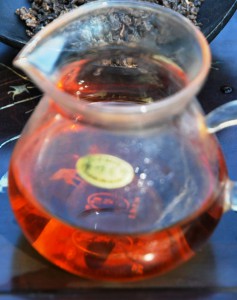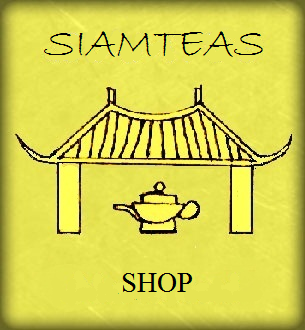DMS Jin Xuan Black Pearls
How black is it, really?
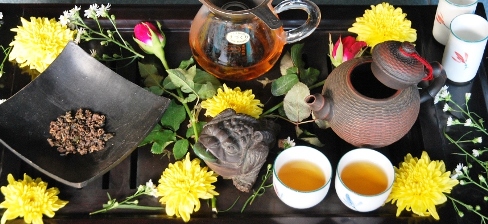
Almost 2 years ago, in the beginning of 2011, when I first introduced the (just “invented”) black tea from North Thailand, the “tea world” initially responded with the same skepticism that I had not been able to completely suppress myself, when my producer partners in Doi Mae Salong proudly announced the news.
Now, said skepticism is typically being history in just that very moment, where our DMS Jin Xuan Black Pearls first meet one’s taste buds, a rule that does not only apply to unprejudiced tea lovers, but equally to tea newbies as well as die-hard fans of classical black tea varieties such as Assam or Darjeeling. In the meantime, the Doi Mae Salong Shi Er Black Pearls have blossomed to one of the most popular bestsellers in the SiamTeas tea portfolio, which we do not only sell to our tea fan circle at Siam Tea Shop, but also successfully to dedicated tea retailers across the world (well, nearly), namely in the US, Australia, Sweden, Czech Republic, France, and the Netherlands.
In both professional and tea lover circles, a discussion has unfolded on whether our DMS Jin Xuan Black Pearls really are a black tea now, or even a red one, or rather a very highly fermented/oxidized Oolong tea instead.
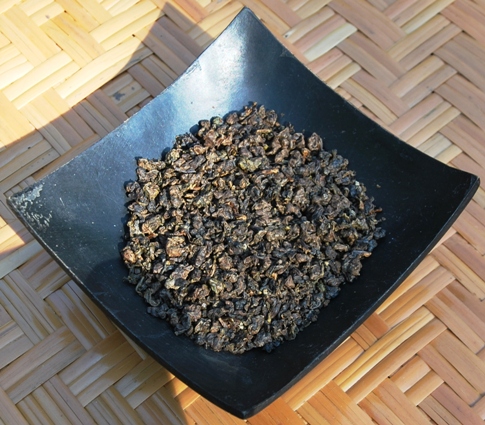 Dark color of the dry “pearls”, with visible green in it
Dark color of the dry “pearls”, with visible green in it
Well, I will not be able to bring final clarification to that question either, if only for the reason that the delimitations of the terms “black tea”, “red tea” and “dark Oolong tea” are overlapping by nature and there are enormous spaces for interpretation, speculation and experiments in the no-man’s-land between the blurred definition borders. Despite the pitfalls of the conceptual definitions, we can position the DMS Jin Xuan Black Pearls quite exactly on the map of basic tea categories. Prerequisite for this, however, will be an initial clarification of the conceptual understanding our three-dimensional axes of coordinates is based on:
Black tea: Western term for “completely” (beyond 94%, as a rule) fermented / oxidized tea of the Camellia Sinensis species, applying regardless of cultivar and region of origin. “Black” means the increasingly dark color of the tea leaves with higher degrees of fermentation / oxidation.
Red tea: Traditional Chinese term for “completely” (beyond 85% or 90%) fermented tea of the Camellia Sinensis species, however only with respect to Chinese teas, simply because ancient China did not know Darjeelings or African black teas, once due to the non-existing globalization in that time, and second because these teas simply did not exist yet in the heyday of the more than 3000 years old Chinese tea culture. “Red” because of the clear red color of the tea’s liquor.
Dark Oolong tea: not a term defined by “science”, however, it is a winged word in tea lover circles, mostly used to describe a tendentiously rather high fermented / oxidized Oolong tea, whereas the rating “dark”, in comparison to green, yellow, or white tea, and/or to less high fermented /oxidized tea applies both to the color the processed tea leaves and that of the tea’s liquor. A binding or even common definition for the range of degree of fermentation applicable to the term does not exist.
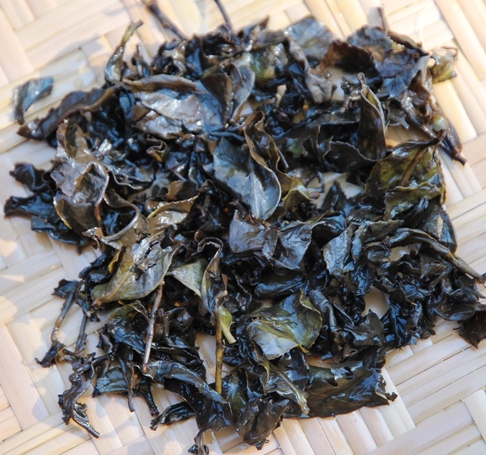 Wet leaves with visible black and green color components
Wet leaves with visible black and green color components
Hence, the concepts behind the terms “black” and “red” tea are widely identical. As I said, widely…. though, who today says “red tea” might usually mean a Chinese black tea, a certain set of taste and processing properties will be attributed to that red/Chinese black tea, which absolutely qualifies red tea as a special form of black tea or even as a class of its own. Here, however, I have to enter grounds of speculation: as it appears, mildness, a modest content in bitters with at the same time aromatic richness and a broad taste spectrum are to some extent typical for Chinese red teas, while the criterion “red” for the tea’s liquor will also be already fulfilled at a slightly lower degree of fermentation / oxidation (90%, or even 85%?), and hence, such tea will be called “red tea” in China, too, while in the west, many might call it a “dark Oolong” instead.
DMS Jin Xuan Black Pearls Facts
Our “Black Pearls”, which consequentially should actually more accurately be called “Red Pearls”, which we won’t do, because this would inevitably cause many people in the west to think of Pu Er tea (or even Rooibus), are produced on the basis of Jin Xuan Oolong No. 12 cultivar (Chin. “12” = “shi er”), simply by processing it to a much higher degree of fermentation / oxidation as is common for the Jin Xuan Oolong No. 12.
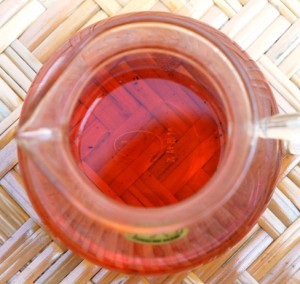 clear red color of the tea’s liquor
clear red color of the tea’s liquor
Naturally, as a non-food-chemist, I cannot tell how high EXACTLY the degree of fermentation of the Black Pearls is, but I estimate it to be typically in the range between 85% and 90%, bringing it right in the middle of the no-man’s-land between black tea and dark Oolong tea on the one hand, but making it fulfill all requirements for a classification as “red tea” on the other.
- dark, almost black leave, however, with clearly recognizable tones of green notes (visible most clearly at the dry, rolled leave, but also at the wet, unfolded leave (see pics);
- saturated, clear red color of the tea’s liquor after appropriate infusion period (with a dominant slightly reddish amber color before that);
- mild in taste, which will show hardly any bitter components even after an infusion period of 4-5 minutes;
- rich aroma accompanied by a broad taste spectrum, reaching from a poignant, nearly dominating, wonderfully sweet cocoa note, via nutty components as they are typical for a whole range of high fermented Chinese teas (whether Oolong or red), up to the earthy, slightly grassy aromas characteristic for Thai Oolongs, the latter, however, with the Black Pearls rather as a faint backdrop.
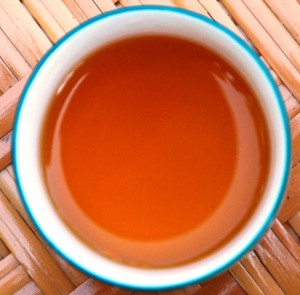 red and amber color in a white tea cup
red and amber color in a white tea cup
Preparation recommendations:
My preparation recommendations for the DMS Jin Xuan Black Pearls are based on my experiences gathered in meanwhile many hundreds of infusions (yes, I LOVE this tea!). Nevertheless, people’s tastes are individual (fortunately), so I don’t intend to set up a rule here that I would consider as mandatory for other tea lovers, too, in order to achieve their most favorable taste result. But precisely because the optimal preparation (for me) of this tea in some points significantly deviates from that of a black tea or even Oolong tea, as we know it, I would like to warmly recommend to at least try the Black Pearls once in accordance with my recommendations:
I infuse DMS Jin Xuan Black Pearls in Chinese Gong Fu Cha style, in a clay pot, where the latter surely is not an absolute must. What this tea definitely benefits from is the pre-warming and moistening of the tea pot as well as the short “wash infusion” as is typical for the Chinese Gong Fu Cha tea ceremony. I dosage by rule of thumb, about 3 grams of DMS Jin Xuan Black Pearls on 250 ml boiling hot water, 90°C ok, but a little beyond will also be just fine. The pre-warming of the tea pot by pouring hot water over it from the outside, and the “wash infusion” from the inside help that the temperature will not drop below a level, where this tea’s taste will no longer optimally unfold, too soon. A high infusion temperature is even the more important considering that DMS Jin Xuan Black Pearls will have to infuse relatively long, best 3 minutes at the least, whereas 4 minutes or even slightly longer will still be absolutely okay. The tea won’t get bitter from the comparably long infusion period, however, it will only this way fully unfold its aromatic wealth and intensity of taste.
With a first steep in the described manner, this tea will still always be good for a second infusion, yes, it would even be a sad waste not to exhaust this option. The second steep needs water of the same temperature as the first, but may not infuse for an even longer period of well 5 minutes. With a proper timing of the first steep as described above, both infusions will be of nearly equal value.
Well, I understand everybody, who says that he/she won’t care too much for the theoretic ” pea counting” of the professional world, that he/she won’t even really have to know, whether the DMS Jin Xuan Black Pearls are a black, red, or dark Oolong tea now, but that ultimately, the subjectively perceived good taste is the only criterion that really matters for them. Nevertheless, I appreciate every piece of knowledge about the tea I am drinking, not only for the addition it will make to my knowledge basis, but I also fancy the idea that in transcendental way, I will even be able to taste my knowledge about origin, processing and history of a tea. Don’t believe this? Those who have DMS Jin Xuan Black Pearls at home in their tea cabinets, and have tried it before reading this article, may now be asked to try this tea now, after reading this article, once again. Now, dare saying, you don’t feel the difference…
Got you curious? Of course, you can order Doi Mae Salong Jin Xuan Black Pearls in Siam Tea Shop:

